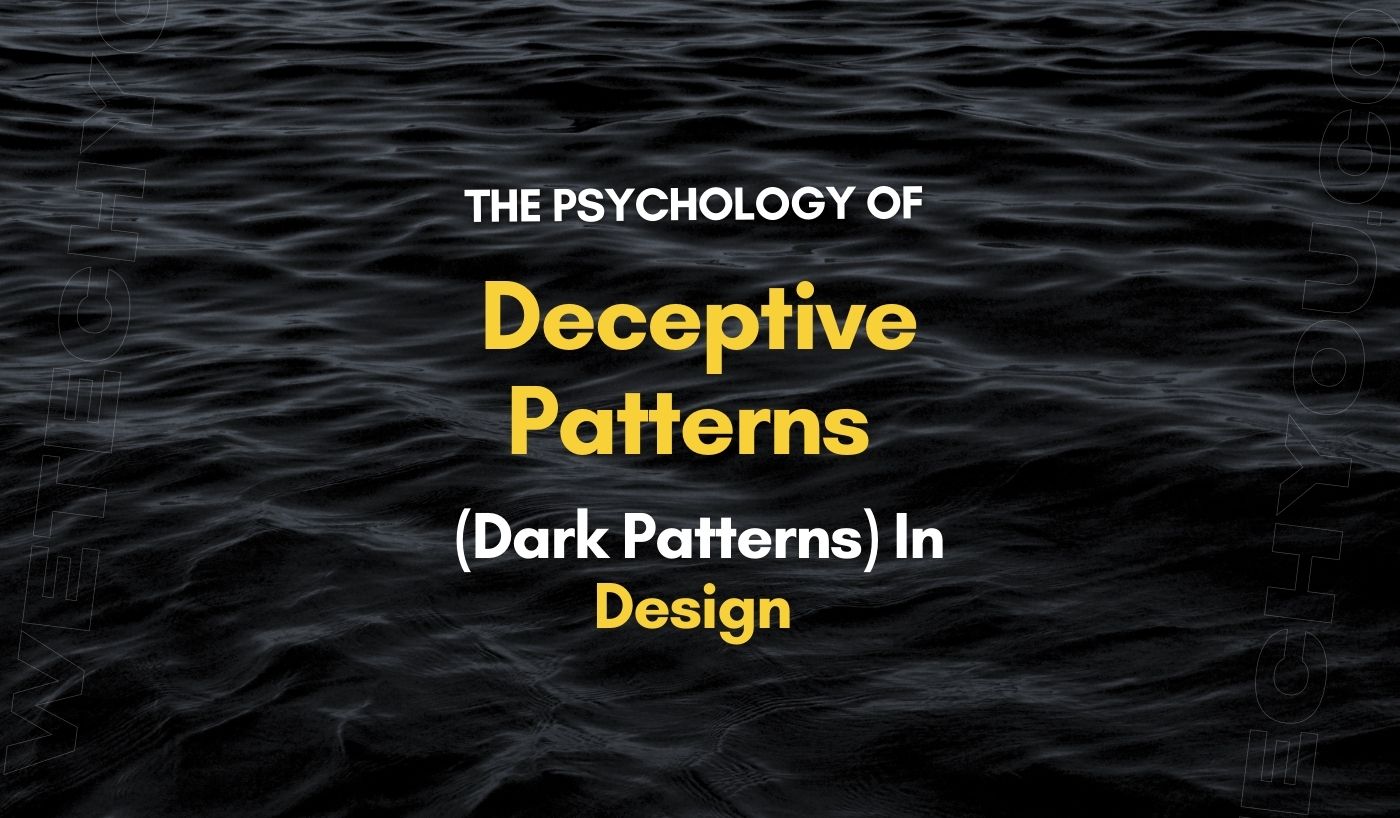In a digital world where design has the power to shape user experiences and influence user actions, a shady side has emerged: deceptive design patterns, also known as ‘Dark Patterns.’ But what exactly are these? They’re clever tactics used in websites and apps, intentionally designed to trick users into doing things they might not want, like buying or signing up for something. This isn’t about improving the user experience; it’s about deception and manipulation, exploiting psychological tricks to benefit the site or app owners.
As we delve into the psychology of these dark patterns, we discuss how they work, their impact, and how they leverage human weaknesses to achieve their goals. Let’s get started.
Understanding Deceptive Patterns: Psychology Behind Dark Patterns
Deceptive design patterns often rely on leveraging the intricacies of human decision-making processes. For instance, one common dark pattern is ‘misdirection.’ Like a magician’s trick, website or app designers can cleverly direct users’ attention toward a specific action, causing them to overlook other options.
For example, you may have noticed that some websites make the ‘subscribe’ button large, bright, and easy to click, while the ‘unsubscribe’ or ‘skip’ option is hidden or less noticeable.
Another common dark pattern is ‘forced continuity,’ where users sign up for a free trial and are automatically charged without explicit consent when the trial period ends. This pattern counts on people forgetting or overlooking the end of the trial period.
For example, a music streaming app may offer a free month trial but requires credit card information to get started. Once the free trial ends, users are automatically shifted to a paid subscription unless they actively cancel the subscription themselves.
These dark patterns work by exploiting common cognitive biases. ‘Misdirection’ leverages the ‘Attentional bias,’ causing users to focus more on visually prominent options. ‘Forced continuity’ plays on the ‘Status Quo bias,’ where users prefer to keep things the same rather than changing them.
Types of Deceptive Patterns
Several types of dark patterns prey on users’ cognitive biases. Here are some of the most common ones:
1- Disguised Ads
Disguised Ads are cunningly designed advertisements that camouflage within a website’s content or layout, tricking users into clicking them inadvertently. These ads exploit the ‘Bait and Switch’ cognitive bias, giving users the impression they’re clicking on something else. This deceptive pattern frustrates users and can erode trust, leading to a negative user experience and potential loss of business.
2- Fake Scarcity
Fake Scarcity is a deceptive pattern that creates a false sense of urgency and scarcity. Websites or apps may display messages such as “Only 2 items left!” or “Sale ends in 1 hour!” to pressure users to make quick decisions without consideration. The psychological principle at play here is called the ‘Scarcity bias.’ it drives users to assign greater value to things, leading to impulsive buying decisions fueled by the fear of missing out on limited offers.
3- Fake Social Proof
This dark pattern involves falsely displaying social proof, such as fake reviews or an inflated number of followers, to create a sense of trust and credibility. This plays on the ‘Social Proof bias principle,’ where people tend to follow others’ actions or opinions. By creating a false image of popularity, websites and apps can manipulate users into believing their product/service is more trustworthy or desirable than it is.
4- Sneak into Basket
Another deceptive design pattern is sneaking items into a user’s basket or cart without explicit consent. This can happen when users select an option, such as ‘Add to Wishlist,’ but the site adds the item directly to the cart. It can also occur when websites automatically add additional items to a user’s cart without their knowledge. This dark pattern exploits the ‘Optimism bias,’ making users believe they’re getting a good deal or freebies without realizing they’ll be charged for it.
5- Forced Action
Forced Action requires users to take an action before proceeding further. Websites or apps may require users to enter their email addresses or complete a survey before accessing content or using certain features. This dark pattern manipulates the principle of ‘Reciprocity bias,’ where we feel obliged to return a favor when someone does something for us. By forcing users to take action, websites or apps hope to receive something in return, such as user data or email subscriptions.
6- Hard to Cancel
‘Hard to Cancel’ is a dark pattern where companies make canceling memberships or subscriptions unnecessarily complex or obscure. They bank on the ‘Effort Justification bias’ where users, deterred by the effort of finding the cancellation option or navigating a convoluted process, simply continue the service, often involuntarily.
7- Hidden Cost
Hidden Cost is a sneaky design pattern that conceals extra fees or charges until the final stage of a transaction, catching customers by surprise. This could include handling fees, taxes, or hidden charges for various features. It exploits the ‘Loss Aversion bias,’ where people want to avoid losing something they already have. In this case, users may feel compelled to continue purchasing, even if unprepared for the additional costs.
8- Comparison Prevention
This dark pattern restricts users from comparing prices, features, or reviews with competitors, limiting their ability to make informed decisions. By manipulating confirmation bias, where people seek information confirming their beliefs, websites or apps prevent users from discovering better alternatives and potentially losing business.
9- Hidden Subscription
The user is offered a free version of the product, and then, buried in the fine print or several steps later, they find out that they’ve been automatically opted-in for a paid subscription. This deceptive pattern counts on users not reading the terms and conditions thoroughly and exploits ‘inattentional blindness,’ where people fail to notice unexpected information.
10- Disguised Obstacles
Disguised Obstacles are hidden hurdles that impede users from completing tasks, such as creating an account or canceling a subscription. This dark pattern leverages the ‘Status Quo bias,’ where people prefer to stick with what they’re familiar with rather than make changes. By making it difficult for users to take certain actions, websites or apps can retain more customers and generate higher profits.
The Impact of Dark Patterns on Users
Dark patterns have a profound impact on users and their overall digital experience. The most immediate effect is frustration and confusion. Users may feel tricked or manipulated when encountering these deceptive patterns, which can be incredibly frustrating and lead to a negative experience. Unwanted costs and subscriptions can also result in financial loss and mistrust towards the website or app.
Moreover, the deceptive patterns contribute significantly to a sense of invasion of privacy. When users are coerced into sharing personal data or are unknowingly tracked, it creates a sense of unease and mistrust.
Over time, this can result in a broader loss of consumer confidence in digital platforms. It’s not just the affected individual users who lose trust; word-of-mouth and online reviews can quickly spread this distrust to a wider audience. This can harm businesses, as maintaining customer trust is paramount in the digital age.
In addition to the negative impact on users, dark patterns also harm businesses in the long run. While these deceptive tactics may lead to short-term gains, they can ultimately damage a company’s reputation and credibility. They can also result in legal consequences if they breach consumer protection laws.
How to Create Ethical UX Designs to Avoid Dark Patterns?
As designers, we must be aware of our designs’ impact on users and strive to create ethical UX. Here are some strategies for avoiding dark patterns in your design:
- Opt-in Clarity: Communicate to users when opting for a subscription or additional fees. Avoid pre-ticking boxes or burying important information in fine print.
- Clear Navigation: Make it easy for users to find and cancel subscriptions, delete accounts, and navigate your website. Avoid creating obstacles that prevent users from taking action.
- Transparent Pricing: Be upfront about all costs and fees associated with a product or service. Avoid hidden costs or charges that could surprise users at the last minute.
- User Testing: Conduct user testing to identify potential dark patterns in your design. Get feedback from real users to ensure your design is intuitive and transparent.
- Consent-Based: Obtain explicit consent from users before using their data or adding items to their cart. Avoid tricking users into sharing personal information or making purchases.
You may also like this: Most Underrated Applications Of UX Design
Conclusion
Dark patterns are deceptive design tactics used by companies to manipulate user behavior. They can lead to frustration, distrust, and loss of consumer confidence. The UX designers are responsible for creating ethical designs that respect the user’s autonomy and avoid dark patterns.
By following best practices and being aware of the impact of their designs, designers can contribute to a more transparent and trustworthy digital landscape for users.
If you are looking for experienced designers who can use this trick to design your branding assets, contact us today. Or have a glance at our digital design services page to know more about how we can help you.




